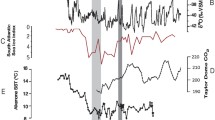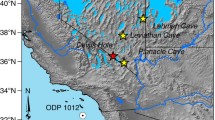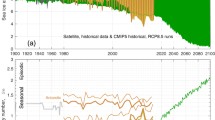Abstract
Progress in understanding how terrestrial ice volume is linked to Earth’s orbital configuration has been impeded by the cost of simulating climate system processes relevant to glaciation over orbital time scales (103–105 years). A compromise is usually made to represent the climate system by models that are averaged over one or more spatial dimensions or by three-dimensional models that are limited to simulating particular “snapshots” in time. We take advantage of the short equilibration time (∼10 years) of a climate model consisting of a three-dimensional atmosphere coupled to a simple slab ocean to derive the equilibrium climate response to accelerated variations in Earth’s orbital configuration over the past 165,000 years. Prominent decreases in ice melt and increases in snowfall are simulated during three time intervals near 26, 73, and 117 thousand years ago (ka) when aphelion was in late spring and obliquity was low. There were also significant decreases in ice melt and increases in snowfall near 97 and 142 ka when eccentricity was relatively large, aphelion was in late spring, and obliquity was high or near its long term mean. These “glaciation-friendly” time intervals correspond to prominent and secondary phases of terrestrial ice growth seen within the marine δ18O record. Both dynamical and thermal effects contribute to the increases in snowfall during these periods, through increases in storm activity and the fraction of precipitation falling as snow. The majority of the mid- to high latitude response to orbital forcing is organized by the properties of sea ice, through its influence on radiative feedbacks that nearly double the size of the orbital forcing as well as its influence on the seasonal evolution of the latitudinal temperature gradient.














Similar content being viewed by others
References
Berger A (1992) Orbital variations and insolation database (contribution 92-007, NOAA/NGDC, Boulder, USA)
Berger A (1978) Long-term variations of caloric insolation resulting from the Earth’s orbital elements. Quat Res 9: 139–167
Blackmon ML (1976) A climatological spectral study of the 500 mb geopotential height of the northern hemisphere. J Atmos Sci 33: 1607–1623
Braithwaite RJ (1995) Positive degree-day factors for ablation on the Greenland ice sheet studied by energy-balance modelling. J Glaciol 41(137): 153–160
Broccoli AJ (2000) Tropical cooling at the Last Glacial Maximum: an atmosphere-mixed layer ocean model simulation. J Clim 13(5): 51–976
Broccoli AJ, Manabe S (1987) The influence of continental ice, atmospheric CO2, and land albedo on the climate of the last glacial maximum. Clim Dyn 1: 87–99
Cook KH, Held IM (1988) Stationary waves of the ice age climate. J Clim 1: 807–819
Cortijo E, Lehman S, Keigwin L, Chapman M, Paillard D, Labeyrie L (1999) Changes in meridional temperature and salinity gradients in the North Atlantic Ocean (30°–72°N) during the last interglacial period. Paleoceanography 14(1): 23–33
Deblonde G, Peltier WR (1991) Simulations of continental ice sheet growth over the last glacial-interglacial cycle: experiments with a one-level seasonal energy balance model including realistic geography. J Geophys Res 96(D5): 9189–9215
Deblonde G, Peltier WR (1993) Late Pleistocene Ice Age scenarios based on observational evidence. J Clim 6: 709–727
Dong B, Valdes PJ (1995) Sensitivity studies of northern hemisphere glaciation using an atmospheric general circulation model. J Clim 8: 2471–2496
Felzer B, Webb III T, Oglesby JR (1998) The impact of ice sheets, CO2, and orbital insolation on late Quaternary climates: sensitivity experiments with a general circulation model. Quat Sci Rev 17: 507–534
Flato GM, Hibler WD (1995) Ridging and strength in modeling the thickness distribution of Arctic sea-ice. J Geophys Res 100(C9): 18,611–18,626
Gallee H, van Ypersele JP, Fichefet T, Marsiat I, Tricot C, Berger A (1992) Simulation of the last glacial cycle by a coupled, sectorially averaged climate-ice sheet model 2. Response to insolation and CO2 variations. J Geophys Res 97(D14): 15,713–15,740
Gallimore RG, Kutzbach JE (1995) Snow cover and sea ice sensitivity to generic changes in Earth orbital parameters. J Geophys Res 100(D1): 1103–1120
Gallimore RG, Kutzbach JE (1996) Role of orbitally induced changes in tundra area in the onset of glaciation. Nature 381: 503–505
Hall NMJ, Hoskins BJ, Valdes PJ, Senior CA (1994) Storm tracks in a high resolution GCM with doubled carbon dioxide. Q J R Meteorol Soc 120: 1209–1230
Hays JD, Imbrie J, Shackleton NJ (1976) Variations in the Earth’s orbit: pacemaker of the ice ages. Science 194: 1121–1132
Held I (1982) Climate models and the astronomical theory of the ice ages. ICARUS 50: 449–461
Imbrie J and coauthors (1984) The orbital theory of Pleistocene climate: support from a revised chronology of the marine d18O record. In: Berger AL, Imbrie J, Hays J, Kukla G, Saltzman B (eds) Milankovitch and climate. D Reidel, Dondrecht, pp 269–305
Imbrie J and coauthors (1992) On the structure and origin of major glaciation cycles 1. linear responses to Milankovitch forcing. Paleoceanography 7(6): 701–738
Imbrie J and coauthors (1993) On the structure and origin of major glaciation cycles. 2. The 100,000-year cycle. Paleoceanography 8(6): 699–733
Joussaume S, Braconnot P (1997) Sensitivity of paleoclimate simulation results to season definitions. J Geophys Res 102(D2): 1943–1956
Joussaume S, Taylor KE (1995) Status of the Paleoclimate Modeling Intercomparison Project (PMIP) In: Gates WL (ed) Proce 1st Int AMIP Scientific Conference. WCRP Report, pp 425–430
Kageyama M, D’Andrea F, Ramstein G, Valdes PJ, Vautard R (1999) Weather regimes in past climate atmospheric general circulation model simulations. Clim Dyn 15(10): 773–793
Khodri M, Leclainche Y, Ramstein G, Braconnot P, Marti O, Cortijo E (2001) Simulating the amplification of orbital forcing by ocean feedbacks in the last glaciation. Nature 410: 570–574
Kutzbach JE (1987) Model simulations of the climatic patterns during the deglaciation of North America. In: The Geology of North America vol K-3, North America and adjacent oceans during the last deglaciation. The Geological Society of America, pp 425–445
Kutzbach JE, Guetter PJ (1986) The influence of changing orbital parameters and surface boundary conditions on climate simulations for the past 18,000 years. J Atmos Sci 43(16): 1726–1759
Labeyrie L, Leclaire H, Waelbroeck C, Cortijo E, Duplessy JC, Vidal L, Elliot M, Le Coat B (1999) Temporal variability of the surface and deep waters of the North West Atlantic Ocean at orbital and millennial scales. In: Clark PU, Webb RS, Keigwin LD (eds) Mechanisms of global climate change at millennial time scales. Geophysical Monograph 112, AGU, Washington DC, pp 77–98
Ledley TS, Chu S (1995) The initiation of ice sheet growth, Milankovitch solar radiation variations, and the 100 ky ice age cycle. Clim Dyn 11: 439–445
Ledley TS, Pfirman S (1997) The impact of sediment-laden snow and sea ice in the arctic on climate. Clim Change 37: 641–664
Lindberg C, Broccoli AJ (1996) Representation of topography in spectral climate models and its effect on simulated precipitation. J Clim 9(11): 2641–2659
Manabe S, Broccoli AJ (1995) The influence of continental ice sheets on the climate of an ice age. J Geophys Res 90: 2167–2190
Manabe S, Stouffer RJ (1980) Sensitivity of a global climate model to an increaseof CO2 concentration in the atmosphere. J Geophys Res 85(C10): 5529–5554
Marsiat I (1994) Simulation of the Northern Hemisphere continental ice sheets over the last glacial-interglacial cycle: experiments with a latitude-longitude vertically integrated ice sheet model coupled to a zonally averaged climate model. Paleoclimates 1(1): 59–98
Masuda K (1988) Meridional heat transport by the atmosphere and the ocean: analysis of FGGE data. Tellus 40A: 285–302
Milankovitch M (1941) Canon of insolation and the ice age problem (Israel Program for Scientific Translations, Jerusalem)
Miller GH, de Vernal A (1992) Will greenhouse warming lead to Northern Hemisphere ice-sheet growth? Nature 355: 244–246
Mitchell JFB (1993) Modelling of paleoclimates: examples from the recent past. Philos Trans R Soc Lond B 341: 267–275
de Noblet N, Prentice IC, Joussaume S, Texier D, Botta A, Haxeltine A (1996) Possible role of atmosphere–biosphere interactions in triggering the last glaciation. Geophys Res Lett 23(22): 3191–3194
Oglesby RJ (1990) Sensitivity of glaciation to initial snow cover, CO2, snow albedo, and oceanic roughness in the NCAR GCM. Clim Dyn 4: 219–235
Peltier WR, Marshall S (1995) Coupled energy-balance/ice-sheet model simulations of the glacial cycle: a possible connection between terminations and terrigenous dust. J Geophys Res 100(D7): 14,269–14,289
Phillipps PJ, Held IM (1994) The response to orbital perturbations in an atmospheric model coupled to a slab ocean. J Clim 7: 767–782
Prell WL, Kutzbach JE (1987) Monsoon variability over the past 150,000 years. J Geophys Res 92(D7): 8411–8425
Rind D, Peteet D, Kukla G (1989) Can Milankovitch orbital variations initiate the growth of ice sheets in a general circulation model? J Geophys Res 94: 12,851–12,871
Ruddiman WF, McIntyre A (1981) Oceanic mechanisms for amplification of the 23,000-year ice-volume cycle. Science 212: 617–627
Shackleton NJ (1987) Oxygen isotopes, ice volume and sea level. Quat Sci Rev 6: 183–190
Shackleton NJ (2000) The 100 000-year ice age cycle identified and found to lag temperature, Carbon dioxide and orbital eccentricity. Science 289: 1897–1902
Short DA, Mengel JG, Crowley TJ, Hyde WT, North GR (1991) Filtering of Milankovitch cycles by Earth’s geography. Quat Res 35: 157–173
Schneider SH, Thompson SL (1979) Ice ages and orbital variations: some simple theory and modeling. Quat Res 12: 188–203
Suarez M, Held IM (1979) The sensitivity of an energy balance climate model to variations in the orbital parameters. J Geophys Res 84(C8): 4825–4836
Tarasov L, Peltier WR (1997) Terminating the 100 ky ice age cycle. J Geophys Res 102(D18): 21,665–21,693
Vavrus S (1999) The response of the coupled Arctic sea ice-atmosphere system to orbital forcing and ice motion at 6 ky and 115 ky BP. J Clim 12: 873–896
Vettoretti G, Peltier WR (2003a) On Post Eemian glacial inception. Part I: the impact of summer seasonal temperature bias. J Clim 16(6): 889–911
Vettoretti G, Peltier WR (2003b) On Post Eemian glacial inception. Part II: elements of a “cryospheric moisture pump”. J Clim 16(6): 912–927
Wang Z, Mysak LA (2001) Ice sheet-thermohaline circulation interactions in a climate model of intermediate complexity, J Oceanography 57: 481–494
Young MA, Bradley RS (1984) Insolation gradients and the paleoclimate record. In: Berger AL, Imbrie J, Hays J, Kukla G, Saltzman B (eds) Milankovitch and climate. D Reidel, Dardrecht, pp 707–713
Author information
Authors and Affiliations
Corresponding author
Appendix
Appendix
Energy is transported to the poles in the form of sensible heat, potential energy, latent heat, and kinetic energy. Because poleward transport of kinetic energy is a small fraction of the total transport we do not include it within our calculations. Given monthly means, one may mathematically calculate energy transported by SE, the MMC, and by all circulations (Total = SE + MMC + TE). Because daily information from the model was not saved, we needed to determine TE as a residual (TE = Total – SE – MMC). This calculation of TE is particularly sensitive to small errors which we have minimized by two means. Firstly we saved monthly means of the triple product of surface pressure, meridional wind velocity and each of the quantities pertaining to air temperature, geopotential height, and specific humidity at every model level as well as the covariance of the meridional wind and surface pressure. Neglecting the time variation of surface pressure from this calculation can seriously undermine the fidelity of the calculation. The second way we minimize errors is by adjusting the meridional winds to yield no net exchange of mass across latitudinal circles (i.e., there are no vertically integrated meridional winds, Hall et al. 1994). Although there can be a true mass flux associated with changes in surface pressure, these fluxes are smaller than the errors introduced by not enforcing this constraint (Masuda 1988). We adjust the meridional winds by the monthly mean of the vertical integral of the covariance between meridional winds and surface pressure. The accuracy of the heat transport calculation can be tested by a comparison between the heat transport calculated directly from the appropriate quantities from the model integration and the heat transport as inferred from the radiative imbalance at the top-of-the-atmosphere. The two curves are both quite smooth and never differ by more than 0.1 PW.
Rights and permissions
About this article
Cite this article
Jackson, C.S., Broccoli, A.J. Orbital forcing of Arctic climate: mechanisms of climate response and implications for continental glaciation. Climate Dynamics 21, 539–557 (2003). https://doi.org/10.1007/s00382-003-0351-3
Received:
Accepted:
Published:
Issue Date:
DOI: https://doi.org/10.1007/s00382-003-0351-3




